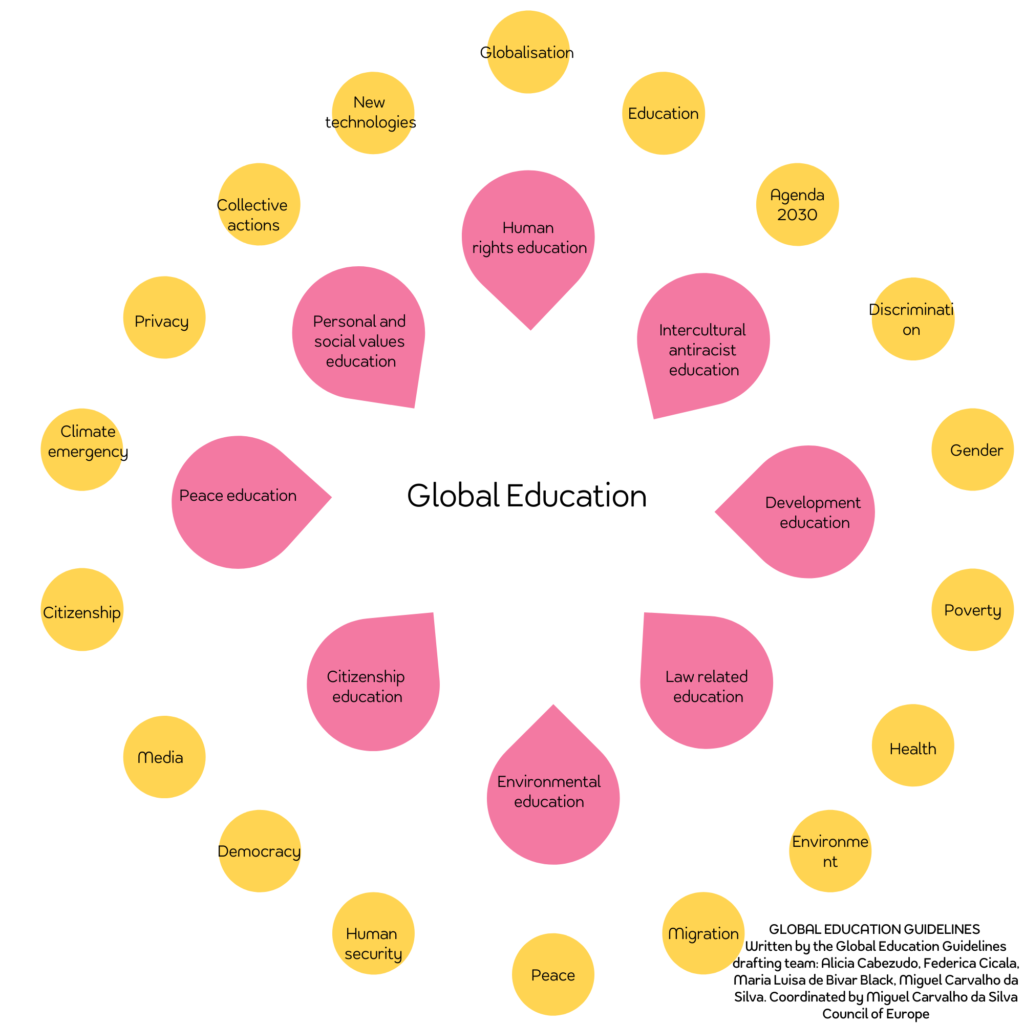“Globally-minded people care about future generations, and so act to preserve the environmental integrity of the planet. Globally-minded individuals exercise agency and voice with a critical awareness of the fact that other people might have a different vision of what humanity needs and are open to reflecting on and changing their vision as they learn about these different perspectives. Rather than believing that all differences can be eliminated, globally-minded people strive to create space for different ways of living with dignity.” (OECD)
A guideline to global education should consider all the cultural, economic, social and geographical realities. Students can learn and understand the global situation better when the content relates to them. Thus involving them in today’s realities and trying together to find solutions, is a great way to global education.
It will help schools offer an education that will prepare young adults for the world.
More than ever, the globalised world we live in asks for an update of the curriculum.
A global education perspective is the best one to follow, as it will help students connect local, worldwide and understand the inequalities. This is how they become global citizens.
What is global education?
Global education is the approach to education that teaches students that we are all interconnected – us as humans, our different cultures, geography, economy and society. And from this, all of the rest develops – such as the skills to engage with global students and thinking as a citizen of the world.
Global education has many definitions and one of them is the Maastricht Global Education Declaration (2002), which states that: “Global education is understood to encompass Development Education, Human Rights Education, Education for Sustainability, Education for Peace and Conflict Prevention and Intercultural Education; being the global dimension of Education for Citizenship.”
It is not about physical things such as flags and food, but more on values and how they can shape them into students lives. Schools, teachers, parents are all in charge of educating young people towards a globalized world. What we all ask ourselves is maybe when is the right time to start global education? What is the appropriate age? I guess there is no certain age as each child is different. What one should pay attention to is the accessibility and the degree of understanding a child has.
Depending on the country where it is taught, global education is perceived slightly differently. However, there is a common ground on all of them and that is global citizens who can contribute to a more peaceful, just and sustainable world.
What does it involve?
1. Languages
2. Cultures
3. Countries
4. Societies
A global education focused on
1. Interdependency
2. Sustainability
3. Awareness towards the environment
4. Human rights
5. Democracy
6. Overcoming the fear of a changing world
7. Fostering international understanding
8. Fostering global responsibility
Learn it from
1. Literature
2. Technology access
3. Community service
4. Internships
Guidelines for global education
There is no easy path nor a shortcut to how and who can help young minds understand the globalized world and help build it. As this is an ongoing process, it surely means ongoing learning for adults who want to educate young people as well. This is why, having some guidelines, will help them stay focused while also making sure they are updated with everything that happens in the world.
Global education practices
In educating global citizens teachers should focus on 4 main dimensions:
Values – human dignity, human rights, cultural diversity, democracy, justice, fairness, equality.
Attitudes – openness, responsibility, respect, tolerance, civic-mindedness.
Skills – analytical and critical thinking, empathy, flexibility, cooperation, adaptability, listening, plurilingual.
Knowledge & Critical understanding – of the self, of the cultures, of the languages, of the economy, of the history, of the environment, of the sustainability.
The interdependence ties among countries raised education responsibility to strengthen shared values as the basis of our society. Education’s role is to teach people to actively engage in today’s world and help this process of globalisation be easier. While economies differ and cultures differ, the process is felt differently and can be harder for some while easier for others. Thus, awareness about this should be raised and young people should understand that while differences become more visible now, international cooperation, active citizenship, trying to find collective solutions can make a difference.
“Making global education a priority demands that teachers develop new understandings, connections, and courage to engage their students with the wider world.”(Suzie Boss)
The manner in which teachers shape the curriculum and add globalization to it is what makes a difference for the view of each young person. There is not a certain course that is entitled to teach global education – teachers of all courses can help teach global education by adding just a tweak in their usual curriculum. Even a mathematics teacher can include global patterns into their curriculum “For instance, a mathematics teacher might invite students to decide whether linear or exponential functions best fit the data on world population growth […]”
Guidelines
1. The main important thing in having a successful global education is to have the correct information on this, so at all times you must be connected to organizations and platforms that have firsthand experience with everything that is happening in the world and know how to transpose it into education.
2. Connect with global education leaders.
3. Understand the extent of global partnerships and develop them through equity.
4. Build relationships with all the other communities in the world.
What does equity above refer to? Partnerships should have at their core “trust, mutual respect, and a shared vision of global collaboration and development.” (Klein, J.D, The Global Education Guidebook) It is not about saving the rest but about working together, sharing experiences, for the good of the planet. It is about appreciation, communication, readiness, flexibility, understanding.
1. Appreciation of the different cultures that exist in the world.
2. Communication in a global language to show you care.
3. Readiness to take upon challenges and answer to the changes appropriately.
4. Flexibility and openness to change.
5. Understanding the significance of a global issue.
In this process, it is essential to bring the world to the students and the students to the world. 
Spark School view
We pride ourselves on our international curriculum and accessibility to a large community of students. However, this is not all our global education is about. The four strands we built our academic courses include the “global awareness” one.
Moreover, as well as critical thinking towards what the textbook offers is essential, we try to develop critical thinking in young people. This way, they can analyse and compensate for inadequacies where necessary, connect intercultural topics to reality.
Conclusion
The essential lesson students should learn for global education to be successful is how to engage with the world around them with empathy, confidence and thoughtfulness.
This is a journey for both adults as it is for young people. However, the degree of understanding may be deeper for adults, this is where the need for them to be educating arises. “Education either functions as an instrument which is used to facilitate the integration of the younger generation into the logic of the present system and bring about conformity or it becomes the practice of freedom, the means by which men and women deal critically and creatively with reality and discover how to participate in the transformation of their world.” Paulo Freire




